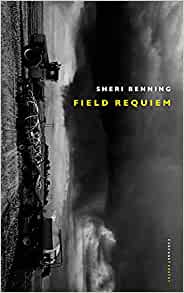Field Requiem
Sheri Benning
(Carcanet, 2021); pPbk: £11.99
[…]we were told
to take what we did not lay down
reap what we did not sow.
(Winter Sleep
Luke 19:11)
Sheri Benning’s Field Requiem is crosshatched with both Biblical and grid references. In the terrifying enormity of the Canadian prairies, which this collection both hymns and mourns, the reader may manage to avoid locating the exact locations (and some may, in any case be fictionalised, wisely), but the layer of the religious aspects cannot be skimmed. The New Testament reference above takes the reader to The Parable of the Minas, which is perhaps less self-evident in its truths than some others.
Field Requiem shares some similarities with what Jim Carruth considered in his own experience of Scottish dairy farming in Bovine Pastoral and more particularly through the Presbyterian lens of his long narrative poem, Killochries. Saskatchewan-born Benning’s glass, however, is expansively Roman Catholic, in keeping with both the culture in focus, and arguably the landscape’s scale.
This is a requiem for an environment, a way of life and for the people who are, and were, part of it. Benning’s telling of the European Canadians’ plight is not blind to the fate of those they displaced. The responsibilities and accountabilities in this deceptively slim volume are immense. In a way which recalls Heaney, the farmed and the farmers are inseparable. Houses are bones. We are shown ‘infant skulls, allium bulbs’ (‘Vespers’), and poems lace charms of wild flower names with those of townships and places. Later those name litanies appear in macaronics of the settler languages brought from central Europe, but also in household products and trade-names, which signal times as much as situations. Then there are the terms of industrialised farm equipment, medicines, and still later all those pesticides and herbicides.
fescue, brome, spear,
bluestem, blue-eyed, hip-high sow-thistle,coyote-scat cairns, creeping smoke
of pasture sage, chipping Sparrow drone.
(‘Vespers’)
Sometimes, in the found poems of deserted churches, those lists need no embroidering in their harrowing toll of infant mortality. Rarely perhaps has ‘tomb’ too-close rhyme with ‘womb’ been so painfully charted in those dutiful older sisters holding the dying in a dustbowl of horror. There is much here which recalls Sebastião Salgado’s documentary photography of lives lived perpetually too near death. The poet’s sister, Heather Benning provides black and white photographs of haunting interior and exteriors of derelict farmsteads.
The collection eulogises the loss of a fragile and increasingly marginalised terrain, pastoral in tandem with its unflinching examination of the desperation endured by the people, caused in MacCaig’s terms, by ‘a remote and ignorant government’. The greed of officialdom’s continuing environmental rape, and the historical sweep of its consequences for humans and the planet is threaded through with the deeply private. The narrative’s universal scope is never devoid of personal connectedness.
Early in the collection, we are offered glorifying hope in ‘Doxology’, but hope is, in truth, in short supply throughout. Death has a heavier presence than life here. This is a stunningly beautiful collection, and I believe a very important one, which in charting the narratives of tragedy, both human and environmental, is unafraid to accuse the governments and multinationals. It is to Benning’s great credit that these searingly wonderful poems, of both lament and fury, are contained by the dignity and empowering control of formal stanzaic structures, and deeply scholarly titling, referencing and sequencing. In this way it is indeed redolent of the Requiem Mass, profoundly moving in its ritualisation and also in its attempt to find a path and truth through darkness.
We wait a long time for the ‘Viaticum’, that last Holy Eucharist given to the dying in preparation for the onward journey. Finally, there is indeed the hope of ‘et lux perpétua lúceat eis –‘
It is notable that light is dawning as Benning moves to her new home, as she finishes with,
I am. I am
There is no going back.
(‘To Glasgow’)
Beth McDonough


Heaney and MacCaig are rightly mentioned, but Benning’s territory (and concerns) particularly brings to mind R S Thomas.
Yes indeed, there’s a great deal of RS Thomas in the collection, too. Very much so.